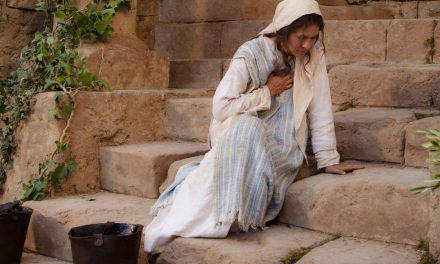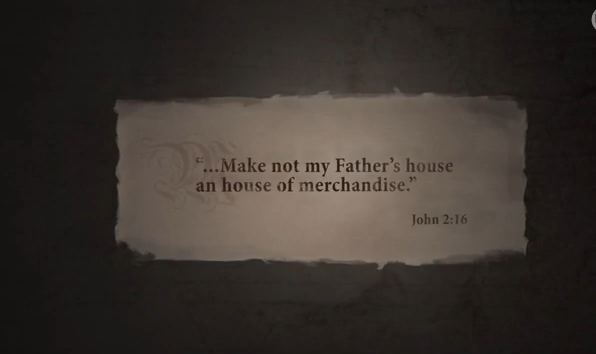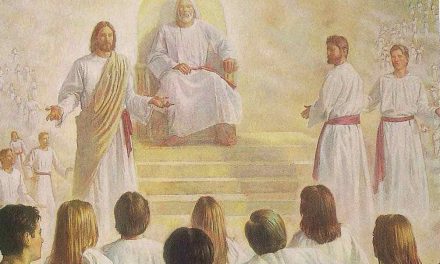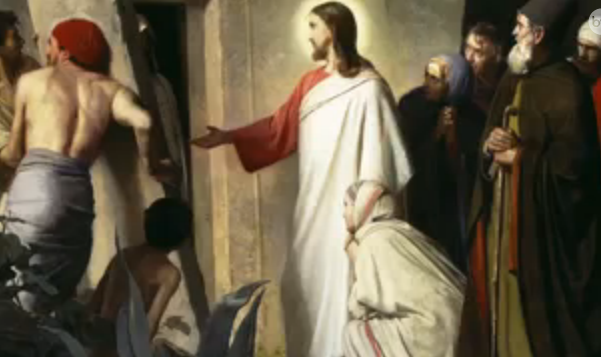CECILIA PEEK: The term Dark Ages, I think, is appropriately applied really to any time in human history when God’s authority in the form of the priesthood is not on the earth. So I think it’s appropriately applied to the years that we traditionally think of as the Dark Ages, in that sense.
On the other hand, the time period that we traditionally think of as the Dark Ages, the Middle Ages, the Medieval period, was a time when deeply religious men and deeply religious scholars were working to try and interpret and understand and articulate their theology and their faith in God in very interesting ways. And in that sense I don’t actually consider it the Dark Ages at all.
MILTON BACKMAN: The Restoration in one sense began when Joseph Smith went into a grove. He was not yet fifteen years of age. And he knelt in prayer, and he was trying to determine which church to join, because he knew he was a sinner. And he asked others, What must I do to be saved? In fact for three years he was seeking and searching, investigating, and he could not find a satisfactory answer. So he went into a grove, believing the admonition of James: “If any man lack wisdom, let him ask of God” (James 1:5). And he knelt down in prayer.
First thing he actually learned was that the power of evil is real and strong. He felt he was nearly destroyed. And then he was relieved, and he saw a light, a brilliant light. And in that light he saw two glorious personages. And he one time said: “Who exactly resembled each other in features and likeness” (History of the Church 4:536).
During this vision, he learned that Jesus is the Christ. That was one of the great truths unfolded, the Atonement of Jesus, that He was the Redeemer and the Savior of the world. And then he also learned at this time about the Second Coming, that Jesus was going to come. So he learned about the Second Coming, he learned a great deal about the Savior of mankind, and he learned about the reality of the apostasy, that the authority was not upon the earth, the doctrines were not upon the earth.
So this vision was just a remarkable vision which introduced to Joseph Smith and the Gospel of Jesus Christ.
SUSAN EASTON BLACK: You think of young Joseph Smith, a young lad growing up in a home where his father is a farmer. He’s out there in western New York, a place called Palmyra, Manchester area. And to even indicate that the Father had appeared to him as well as the Son. Extraordinary. I don’t believe that Joseph Smith when he came out of the grove literally grasped that the Restoration was a process, and that this was the opening scene.
MICHAEL D. RHODES: There are several Old Testament prophecies that talk about speaking from the dust, things coming from the dust. And they certainly make it clear that this has reference to that coming forth of the Book of Mormon, preceding the Second Coming of Christ. “I will hear what God the Lord will speak, for he will speak peace unto his people, and to his saints. Truth shall spring out of the earth, and righteousness shall look down from heaven” ” (Psalm 85:8, 11) And nice imagery there of revelation coming up from the ground below as well as revelation coming from on high.
PAUL Y. HOSKISSON: We realize that the Book of Mormon is one of the signs of the times. Its coming forth heralds the beginning of the latter days and the restoration of the Gospel of Jesus Christ. This of course was talked about—the coming forth of the Book of Mormon—in several prophesies in the Old Testament.
Verse 4: “And thou shalt be brought down, and shalt speak out of the ground, and thy speech shall be low out of the dust, and thy voice shall be, as of one that hath a familiar spirit, out of the ground, and thy speech shall whisper out of the dust” (Isaiah 29:4).
The Hebrew here also has another meaning here, that I think is really quite important. When we look back in the Old Testament to the Hebrew word behind this familiar spirit, ov, it’s talking about a spirit that is speaking from the dead. Certainly the Book of Mormon has a familiar spirit. When you read it for the first time it’s familiar. It’s something that you recognize. And I think that’s true both of our Bible and our Book of Mormon. These are the ancient prophets who’ve long been dead and who have been buried, who are speaking to us from the earth, out of the dust.
JOHN TANNER: It’s significant that the very last words that Jesus speaks here on the Mount of Olives to his disciples prior to his ascending to heaven prophesy of the sign that shall occur before he comes again in great glory: Ye shall be witnesses unto me, both in Jerusalem and in all Judea, and in Samaria, and unto the uttermost part of the earth.
This is like a prophecy he gives prior to his crucifixion: For “the gospel of the kingdom shall be preached in all the world, for a witness unto all nations” (Matthew 24:14). Not until He comes again will this come to pass.
 MICHAEL RHODES: v’daber alechem komar adonai yahweh hinneh ani loqeha et baneh yisra’el miben hagvoyim asher halekusam v’qibas’ti otam misaviv v’habeti votam el ad’matam: v’asiti otam l’gvoy ehad…. “Say to them, Thus saith the Lord God, Behold, I will take the children of Israel from the nations where they have gone, and I will gather them together from those nations, and bring them to their own land. And I will make them one people” (Ezekiel 37:22). Fulfilled beautifully as we see the gospel of Jesus Christ preached throughout the world, primarily using the Book of Mormon as a tool to gather together scattered Israel from all over the world.
MICHAEL RHODES: v’daber alechem komar adonai yahweh hinneh ani loqeha et baneh yisra’el miben hagvoyim asher halekusam v’qibas’ti otam misaviv v’habeti votam el ad’matam: v’asiti otam l’gvoy ehad…. “Say to them, Thus saith the Lord God, Behold, I will take the children of Israel from the nations where they have gone, and I will gather them together from those nations, and bring them to their own land. And I will make them one people” (Ezekiel 37:22). Fulfilled beautifully as we see the gospel of Jesus Christ preached throughout the world, primarily using the Book of Mormon as a tool to gather together scattered Israel from all over the world.
“Moreover, thou son of man, take thee one stick, and write upon it, For Judah, and for the children of Israel his companions: then take another stick, and write upon it, For Joseph, the stick of Ephraim, and for all the house of Israel his companions: And join them one to another into one stick; and they shall become one in thine hand”(Ezekiel 37:16–17).
KERRY MUHLESTEIN: Ezekiel 37 is wonderful because of its prophecies about the coming forth of the stick of Judah and the stick of Joseph. As Latter-day Saints sometimes I think we read this a little bit simplistically, and we do ourselves a disservice when we talk to our Christian friends and our Jewish friends about it with a simplistic understanding. Because if you read the context, and you read it carefully and understand what it’s about, it’s primarily about tribes. We like to think about the sticks as being sticks that they rolled scrolls around. And I think that there is something to that, but the primary meaning is that the tribe of Judah and the tribe of Joseph, who have characteristically throughout their history been at war as the kingdom of the south and the kingdom in the north, or the kingdom of Judah and the kingdom of Israel—or at least there’s been tension between them—that as the Second Coming comes about, they will come together.
And so when he talks about the sticks coming together, he’s primarily talking about these two tribes coming together. And yet in the midst of that there’s this wonderful little second meaning. And so many prophecies, especially people like Isaiah and Jeremiah and Ezekiel intend a double meaning to their prophecies. The second meaning is the instrument that will bring about the two tribes coming together.
PAUL HOSKISSON: There were several writing systems that were current at the time. They could write on parchment, they could write on vellum. The Babylonians wrote on clay. And they also had what are later called a diptych, that is a wooden board that has a depression in it, and it’s filled with wax, and then you could take notes on it. It was really something to take notes on. And when you’ve taken your notes and finally transferred it to something more permanent, you just smooth out the wax, and you could use it over and over and over again. And he’s talking about, take two of these tablets that you have to write on and, and let’s write down something. Let’s take one of them for Joseph—for Ephraim, and one of them for Judah. And we know that those are referring then of course to the Old Testament and probably the New Testament coming from the house of Judah, and the Book of Mormon coming from the house of Ephraim. And it’s a very remarkable prophecy that he makes there. Of course what the Book of Mormon is supposed to do, as it continues there in chapter 37, when it comes forth, it’s supposed to unite the two houses, it’s supposed to bring them together with correct doctrine and correct understanding, and knowing who Jesus Christ was and the Messiah.
ANDREW SKINNER: Speaking of a latter day gathering of Israel, the prophet Jeremiah said in the name of the Lord God Israel: “Behold, I will gather them out of all countries, whither I have driven them, . . . and I will bring them here again unto this place, and I will cause them to dwell safely: . . And I will make an everlasting covenant with them, . . . and I will plant them in this land assuredly with my whole heart and with my whole soul” (Jeremiah 32:37–41). This prophetic statement conveys the idea not only of a spiritual gathering, but also of a literal physical gathering to this land that was promised by God to Abraham, Isaac, and Jacob long ago.
CAMILLE FRONK OLSON: To me the gathering of Israel, and the promise, and how important that is to the Lord, all comes back to the great Abrahamic covenant. In that covenant the Lord promised Abraham that through his children, Abraham’s children, all the families of the earth would be blessed, would be taught the gospel. And those who would believe in that gospel would be brought into that covenant. That promise of the Abrahamic covenant is the thread that weaves all through all the Gospels, all these books of scripture, every dispensation. And the reminder is that once you know that you are a child of Abraham, that you have come into that covenant, there’s that remarkable responsibility and opportunity that Jeremiah prophesied, that he would take fishers and send them out to fish the men and women of the world. The whole idea that once we know we are a son or daughter of Abraham, is that remarkable opportunity to go out and help others come to find it. That grafting into the tree, Jesus Christ, the tree of life in Lehi’s dream, that grafting in, coming to Christ, and being sealed to him, being part of his family is the promise of the gathering of Israel. He has not forgotten his children. As Isaiah talked of him that He has engraven us in the palms of his hand. He will not forget us. And the gathering is a powerful evidence that that covenant is real.
ANDREW SKINNER: When I came years ago to the city of Jerusalem, it was in the process of being reconstructed. It’s not nearly the way that it is now. And I was walking through one of the plazas in the Jewish Quarter of Jerusalem, and I saw older men walking with hands behind their backs, women pushing babies in carriages, and children playing in the plaza. And I thought of this particular passage: “Thus saith the Lord; I am returned to Zion, and will dwell in the midst of Jerusalem: and Jerusalem shall be called the city of truth; and the mountain of the Lord of Hosts the holy mountain. Thus saith the Lord of Hosts; There shall yet old men and old women dwell in the streets of Jerusalem, and every man with his staff in his hand for very age. And the streets of the city shall be full of boys and girls playing in the streets thereof” (Zechariah 8:3–5). And I am quite sure that after the destruction of the first temple in 586 B.C. and the destruction of the second temple in 70 A.D., and even with the challenges that were thrust upon the newly established state of Israel in 1948, no one could have ever predicted so accurately what the Lord would bring about in His own due time, and He has, and I’ve seen that.
And I learned a valuable lesson. You’re always better off to trust in the promises of the Lord than to put your faith in secular scholarship. Because scholarship couldn’t have predicted what we literally see unfolding before our very eyes right now.
NOEL B. REYNOLDS: The gathering has both a literal and a spiritual dimension to it. And certainly the Jewish view of it has pretty much always been focused on the literal gathering of those who are of the blood of Israel. It is the case that because of this literal understanding, that throughout history people throughout the world have been acquainted with the idea that God can have covenants with people on earth which He will fulfill.
CAMILLE FRONK OLSON: “And then shall the remnants, which shall be scattered abroad upon the face of the earth, be gathered in from the east and from the west, and from the south and from the north; and they shall be brought to the knowledge of the Lord their God. And the Father hath commanded me that I should give you this land, for your inheritance” (3 Nephi 20:13–14)—so telling of another promised land and another inheritance. And then it goes on to tell them that as the seed of Abraham, that the Father has raised me up to you first and sent me to bless you in turning every one of you from your iniquities, that then you can go out and bring others.
President Kimball made reference to that as he talked about those who come to Christ in the land of Mexico. Mexico will become a land of inheritance for them. And those in Sweden will make the land of inheritance Sweden. Suggesting again, wherever there are God’s people who have made the covenant, wherever a temple can be built, we have a land of inheritance, we have a powerful reminder of God’s presence, where He will teach, protect, and direct them to receive the fullness of the gospel.
NOEL REYNOLDS: In the final analysis, this is about the beliefs and the faith of individuals. And so we see that all the gathering images finally come down to this point: that for every human being, the question is, will they repent, and will they believe in the Holy One of Israel? And if they will, they will be gathered in.
KENT BROWN: These gates, now blocked up, on holidays and at times of prayer would have filled with worshipers coming in and out. They would come out these gates, step on to these steps, which are still original. And they would have come down past the man born blind. For it’s here that Jesus finds this man and heals him. You remember the story, that He takes mud and anoints his eyes, sends him down the hill to the Pool of Siloam, and he comes back seeing.
I believe that this miracle contrasts with the prior miracle in John’s Gospel, wherein Jesus heals a man on the other side of the temple grounds who’s been ill for 38 years. That man rejected him; this man, born blind, accepted him.
I think that’s the conundrum that faces everyone of course. How do I respond to this Jesus? And that will be the case until the Second Coming.








